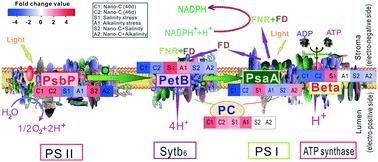当前位置:
X-MOL 学术
›
Environ. Sci.: Nano
›
论文详情
Our official English website, www.x-mol.net, welcomes your
feedback! (Note: you will need to create a separate account there.)
Graphene enhances photosynthesis and the antioxidative defense system and alleviates salinity and alkalinity stresses in alfalfa (Medicago sativa L.) by regulating gene expression
Environmental Science: Nano ( IF 5.8 ) Pub Date : 2021-06-23 , DOI: 10.1039/d1en00257k Zhao Chen 1 , Junpeng Niu 1 , Zhipeng Guo 1 , Xin Sui 1 , Nan Xu 1 , Hafiz Abdul Kareem 1 , Mahmood Ul Hassan 1 , Mingke Yan 1 , Quan Zhang 2 , Jian Cui 3 , Junmei Kang 4 , Zhaolan Wang 5 , Fugui Mi 6 , Đura Karagić 7 , Quanzhen Wang 1
Environmental Science: Nano ( IF 5.8 ) Pub Date : 2021-06-23 , DOI: 10.1039/d1en00257k Zhao Chen 1 , Junpeng Niu 1 , Zhipeng Guo 1 , Xin Sui 1 , Nan Xu 1 , Hafiz Abdul Kareem 1 , Mahmood Ul Hassan 1 , Mingke Yan 1 , Quan Zhang 2 , Jian Cui 3 , Junmei Kang 4 , Zhaolan Wang 5 , Fugui Mi 6 , Đura Karagić 7 , Quanzhen Wang 1
Affiliation

|
Soil salinity and alkalinity are important factors affecting the growth, development, and productivity of alfalfa (Medicago sativa), while nanomaterials could affect the growth and alleviate stress. However, the molecular regulation mechanisms remain largely unknown about how nanoparticle-treated alfalfa responds and adapts to the abiotic stress. We sequenced the transcriptomic changes in graphene-treated leaves under salt and alkali stresses. A total of 19.4 Gb of clean reads were generated by SMRT sequencing including 265 811 CCS and 219 162 FLNC reads, and 12 960 non-redundant transcripts were obtained. RNA-seq analysis revealed 930, 1114 and 880 DEGs in leaves treated with graphene, graphene–salt and graphene–alkali, respectively, among which hundreds of genes are involved in hormonal signaling, photosynthesis, respiration, and transcriptional regulation pathways. Notably, specific differential gene expression patterns such as the antioxidant defense system and photosynthesis may rapidly confer abiotic tolerance in alfalfa leaves treated with graphene. Moreover, the physiological changes were consistent with the complex transcript profiles of the genes involved, suggesting that photosynthesis and the antioxidant defense mechanism played a critical role in reacting to salt and alkali stresses. These observations provide a full characterization of gene transcription and promote the understanding of the molecular mechanisms of nanoparticle-treated alfalfa adaptation to abiotic stresses.
中文翻译:

石墨烯通过调节基因表达增强紫花苜蓿 (Medicago sativa L.) 的光合作用和抗氧化防御系统并减轻盐度和碱度胁迫
土壤盐碱度是影响苜蓿(Medicago sativa)生长、发育和生产力的重要因素),而纳米材料可以影响生长并减轻压力。然而,纳米颗粒处理的苜蓿如何响应和适应非生物胁迫的分子调控机制在很大程度上仍然未知。我们对盐和碱胁迫下石墨烯处理过的叶子的转录组变化进行了测序。SMRT测序共产生了19.4 Gb的clean read,包括265 811 CCS和219 162 FLNC read,获得了12 960个非冗余转录本。RNA-seq 分析显示,在用石墨烯、石墨烯-盐和石墨烯-碱处理的叶子中分别有 930、1114 和 880 个 DEG,其中数百个基因涉及激素信号传导、光合作用、呼吸和转录调控途径。尤其,特定的差异基因表达模式,如抗氧化防御系统和光合作用,可能会迅速赋予用石墨烯处理过的苜蓿叶中的非生物耐受性。此外,生理变化与所涉及基因的复杂转录谱一致,表明光合作用和抗氧化防御机制在对盐和碱胁迫的反应中起着关键作用。这些观察结果提供了基因转录的完整表征,并促进了对纳米颗粒处理的苜蓿适应非生物胁迫的分子机制的理解。表明光合作用和抗氧化防御机制在对盐和碱胁迫的反应中起着关键作用。这些观察结果提供了基因转录的完整表征,并促进了对纳米颗粒处理的苜蓿适应非生物胁迫的分子机制的理解。表明光合作用和抗氧化防御机制在对盐和碱胁迫的反应中起着关键作用。这些观察结果提供了基因转录的完整表征,并促进了对纳米颗粒处理的苜蓿适应非生物胁迫的分子机制的理解。
更新日期:2021-07-23
中文翻译:

石墨烯通过调节基因表达增强紫花苜蓿 (Medicago sativa L.) 的光合作用和抗氧化防御系统并减轻盐度和碱度胁迫
土壤盐碱度是影响苜蓿(Medicago sativa)生长、发育和生产力的重要因素),而纳米材料可以影响生长并减轻压力。然而,纳米颗粒处理的苜蓿如何响应和适应非生物胁迫的分子调控机制在很大程度上仍然未知。我们对盐和碱胁迫下石墨烯处理过的叶子的转录组变化进行了测序。SMRT测序共产生了19.4 Gb的clean read,包括265 811 CCS和219 162 FLNC read,获得了12 960个非冗余转录本。RNA-seq 分析显示,在用石墨烯、石墨烯-盐和石墨烯-碱处理的叶子中分别有 930、1114 和 880 个 DEG,其中数百个基因涉及激素信号传导、光合作用、呼吸和转录调控途径。尤其,特定的差异基因表达模式,如抗氧化防御系统和光合作用,可能会迅速赋予用石墨烯处理过的苜蓿叶中的非生物耐受性。此外,生理变化与所涉及基因的复杂转录谱一致,表明光合作用和抗氧化防御机制在对盐和碱胁迫的反应中起着关键作用。这些观察结果提供了基因转录的完整表征,并促进了对纳米颗粒处理的苜蓿适应非生物胁迫的分子机制的理解。表明光合作用和抗氧化防御机制在对盐和碱胁迫的反应中起着关键作用。这些观察结果提供了基因转录的完整表征,并促进了对纳米颗粒处理的苜蓿适应非生物胁迫的分子机制的理解。表明光合作用和抗氧化防御机制在对盐和碱胁迫的反应中起着关键作用。这些观察结果提供了基因转录的完整表征,并促进了对纳米颗粒处理的苜蓿适应非生物胁迫的分子机制的理解。











































 京公网安备 11010802027423号
京公网安备 11010802027423号